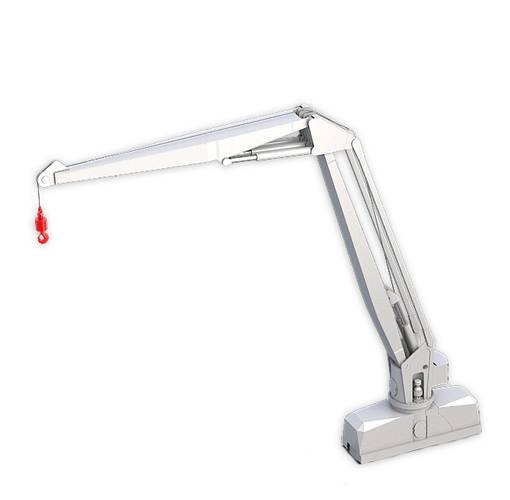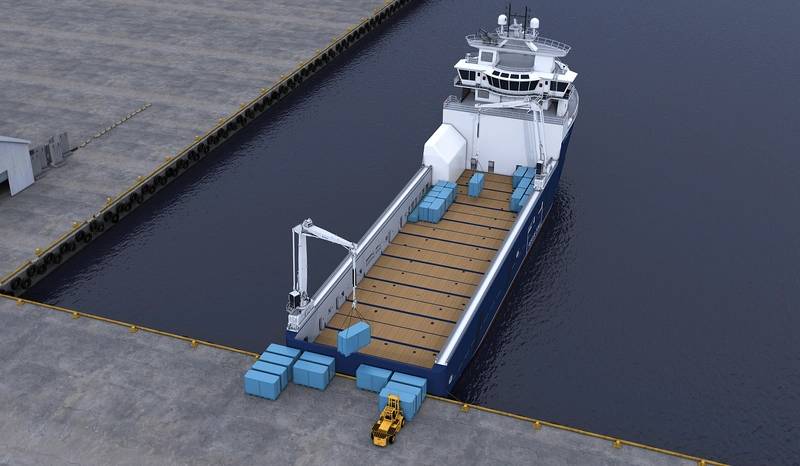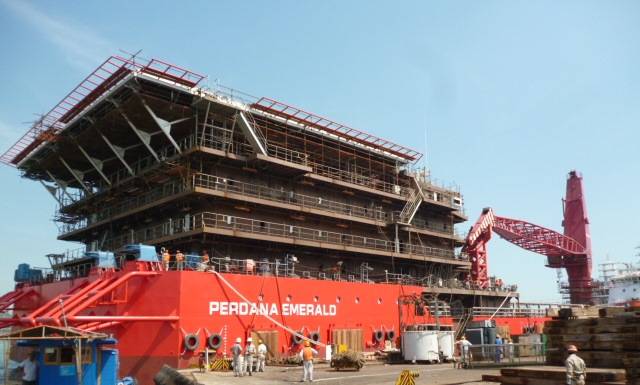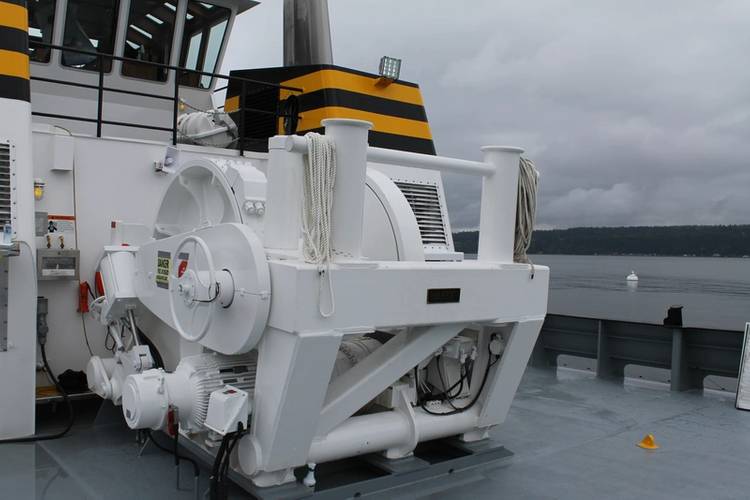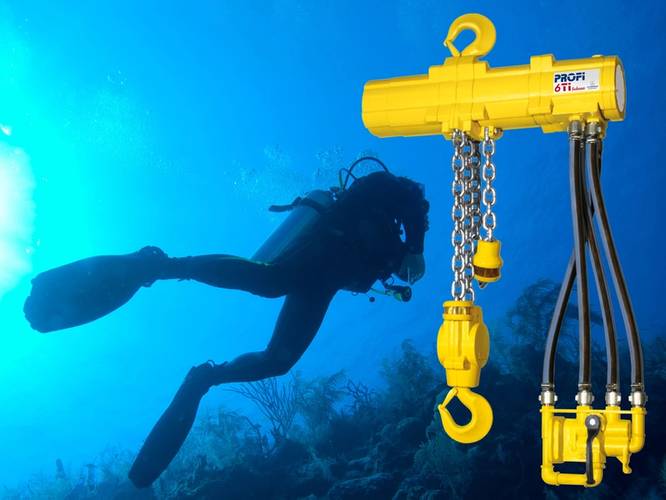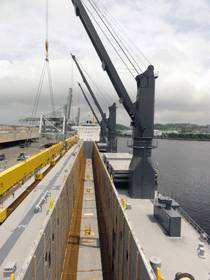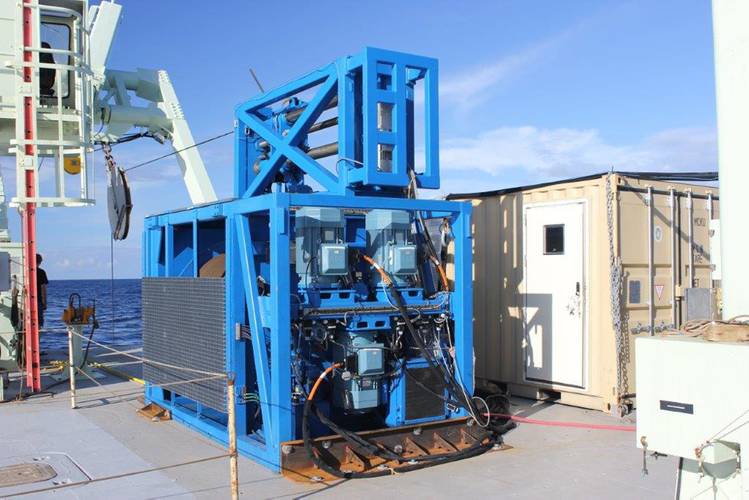Focus: Heavy Duty Lifting
Safely, efficiently lifting and handling increasingly heavy loads takes a hefty dose of the latest heavy lift products and systems.
Rolls-Royce is a ubiquitous and growing force in all matters maritime, inching toward the one-stop-shop premise. It is particularly well known in the deck machinery sector, and it recently signed a deal with Detroit Chile SA to supply offshore cranes to nine PSVs under construction at Detroit Brasil Ltda. shipyard, in Itajaì, Brazil. The order includes nine ship sets of the dual draglink crane, making 18 cranes in total. The Guido Perla-designed vessels (pictured right)will enter service on an eight-year contract with Petrobras, operated by Starnav Serviços Marìtimos Ltda, a subsidiary of Detroit Chile.
Launched in 2012, the Rolls-Royce dual draglink crane has already been delivered to Farstad Shipping’s vessel Far Solitaire, one PSV under construction at Keppel Singmarine Brazil SA, as well as to four PSVs still under construction at Detroit Brasil shipyard, in Itajaì.
Crane systems manufactured by the JD Neuhaus company can be supplied with Atex classifications EX II 2 GD IIA T4 / EX II 3 GD IIB T4, with increased spark protection also available for explosion level II C. All load lift, lower and traverse operations operate off a pneumatic air-line pressure of 85psi (6 bar), with optional hydraulic operating systems also available, eliminating the potential hazards and dangers associated with electrically powered equipment when operating within areas of high dust or humidity.
The JDN range covers both single and double girder overhead traveling cranes, together with slewing jib cranes and underslung cranes incorporating purpose designed low headroom hoist trolley designs. Cranes with individual hoists having load capacities up to 100 metric tons can be supplied, as well as multiple hoist crane products operating with single or twin parallel beams, while also providing individual or synchronized hoist control systems.
For offshore lifting operations, including on sea going vessels, cranes can be supplied with rack and pinion drive systems for safe operation even in bad weather conditions. Super-silent operation is combined with sensitive controls including an automatic safety function for load-lowering in the event of power supply failure. Specialist products for the oil and gas industry include an 80 metric ton double girder overhead travelling design for ‘xmas tree’ handling on a semi-submersible rig. Another purpose-designed product provided a 200 metric ton lift capacity for handling BOP equipment offshore. Cranes for use in the corrosive atmospheres of the galvanic industry have also been supplied.
MacGregor signed a series of deck machinery orders for 12 vessels with Sinopacific Shipbuilding Group. The equipment orders are for two vessel types, anchor handling tug supply (AHTS) vessels and platform supply vessels (PSVs), and they include MacGregor anchor handling/towing winches, shark jaws, towing pins and other deck machinery. Equipment deliveries between January and October 2015 will include:
• Three 61.8m, 1,700 dwt PSVs being built to an SPP17A design for Mexican shipping company, Naviera Petrolera Integral S.A. de C.V. They will be used by PEMEX in the Gulf of Mexico;
• Four 64m, 60-metric-ton bollard pull AHTS vessels, being built to an SPA60 design for Singapore’s Vallianz Holdings Limited, to serve Middle East, Latin American and Asia Pacific markets. Each shipset will include a 150-metric-ton line pull MacGregor anchor handling/towing winch, 200-metric-ton shark jaws and towing pins and other deck machinery;
• Two 81.75m, 4,000 dwt PSVs being built to an SPP35M design for Shenzhen Huawei Offshore Shipping Transport Co Ltd, a subsidiary of Shanghai Salvage Company in China; and
• Three 70.8m/85-metric-ton bollard pull AHTS vessels are being built to an SPA85L design for Shenzhen Huawei Offshore Shipping Transport.
MacGregor secured another significant offshore order, but this one was a bit different in that it is a winch package contract from Nam Cheong Limited group. Eight-point MacGregor mooring systems, with a 150-metric-ton line pull/270-metric-ton brake holding capacity, tugger winches and capstans have been specified for two new 500-person accommodation work barges being built at the yard. The 123-meter barges are scheduled for delivery in 2016, and when they are completele they are scheduled to enter service for one of the largest accommodation/work barge specialists in Asia, Perdana Petroleum Berhad.
Bay Delta Maritime commissioned a sixth Delta Class Tug built by Nichols Brothers Boat Builders. Designed by Jensen, M/V Delta Audrey is a 100 x 40-ft. Z-drive tractor tug powered by a pair of Caterpillar 3516C diesel engines coupled to the Rolls Royce propulsion package, a combined 6800 hp producing 93 tons of bollard pull. It features two Markey winches; one forward for ship assist and one aft for towing. The two winch suite includes the Markey Model DEPCF-52-75HP Class II Hawser Winch and the TES-40 Tow Winch. The DEPCF-52 has a drum capacity for up to 750 ft. of 9.5-in./10-in. soft-line and has a rated performance of 30,800 lbs. at 378 ft./min. Included in the package is the Markey Render/Recover feature that allows for hands free operation at up to full rated line-speeds and line-tension. The TES-40 is sized for up to 2800 ft. of 2.25-in. wire rope (26 x 48 x 76) with an air-controlled drum brake and drum disconnect clutch and an 18-in. diameter warping head. The TES-40 rated performance at barrel layer is 154,000 lbs. stall line-pull and 110,200 lbs. running line-pull at 20 ft./min.
Western Towboat Company chose Rapp Marine U.S. to build a custom towing winch for the new vessel Bering Titan. The main drum capacity for the winch is over 3200 ft. of 2.25-in. steel cable, with an additional 2700 ft. of 2-in. cable stored onto the smaller drum. The pull at the first layer is rated at 25 tons (Metric Tons). The Rapp four motor hydraulic drive is equipped with three speed steps, providing speed range from 30 m./min. up to 124 m./min.
On the east coast, Rapp scored a nice contract win providing the world-renowned Woods Hole Oceanographic Institution (WHOI) a CTD winch for the new research vessel R/V Alucia. Rapp’s TBW-520E-T90 winch accommodates 7,000 m of .322 Rochester Fiber-Optic cable, plus 100 ft. of 2.25-in. synthetic tether. It has Active Heave Compensation (AHC) set for optimal use at 3000 meters of deployed line.
Staying underwater, divers often work alone in variable depth water pressures and temperatures, combined with poor visibility while also battling ocean currents. JD Neuhaus offers hoists with lift capacities from 550 lbs. up to 100 metric tons, with specialized units of 200 metric tons lift capacity having been supplied for BOP handling. The development of subsea hoists means that underwater as well as on-deck lifting operations for a wide range of operational, maintenance and repair functions can be undertaken on jack-up rigs, semi-submersible platforms, drill ships and FPSO vessels. The viability of JDN hoists was on display when its air operated hoists were used for the removal and replacement of a 50-ton rudder on a fully loaded bulk carrier. After a breakdown on a voyage from Brazil to China, the ship was first towed to a safe mooring off the coast of Venezuela, where the rudder removal and replacement work was undertaken. Three standard air operated JDN Profi 25 metric ton capacity hoists were used in conjunction for this operation, with these units being subject to full rebuild procedures after the job completion. The work was successfully undertaken at sea, without the need for cargo removal or transfer.
Mitsubishi Heavy Industries (MHI) completed delivery of the first three units of a 50-ton deck crane featuring a newly-developed synchronized control system, for a long-cargo transport ship constructed by Shin Kurushima Dockyard Co., Ltd. The synchronized control system of the three deck cranes enables safe and efficient loading and unloading of long cargo, playing a major role in the world’s longest long-cargo transportation project.
The synchronized control system is designed to allow simultaneous and uniform control of three deck cranes by a single operator, for hoisting and jib elevation tasks. In addition to operations from the operator’s cabin, operations can also be controlled remotely on deck. A (patent-pending) function that enables switching of the hook control reference position to either the hull or wharf is also provided. This function enables smooth cargo handling irrespective of the hull’s inclination.
Besides the safety features provided on standard cranes, the new 50-ton deck cranes are equipped with precaution alarms by a buzzer and lamps depending on the applied load and an automatic stop function as an overload protection system. The new deck cranes also have a “deviation-overrun” function that halts operation when the deviation of the hook position or the jib angle between the three cranes exceeds its tolerance, as well as a function to provide operation priority to the controller of either the cabin or the deck.
Maintaining Control
Flexible Control for Winches and Cranes
Rexroth developed a new control solution it says is suitable for both simple and complex winch and crane drives. The control system is designed to easily be connected to a system using predefined interfaces. In the software, for example, the designer can access standardized modules for control functions. Integrated security features ensure compliance with the required safety level. The modular structure of the software makes using the control system flexible, in both simple and complex applications. The designer can freely choose the degree of networking, also in terms of security features, according to the specific application requirements.
Originally developed for mobile applications, the controller is designed especially for use in harsh environments, as it can withstand large temperature changes as well as vibrations and shocks. The control solution is also compact and can be installed space saving on deck.
(As published in the November 2014 edition of Maritime Reporter & Engineering News - http://magazines.marinelink.com/Magazines/MaritimeReporter)










